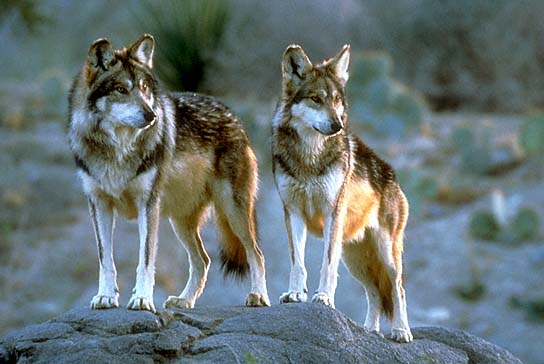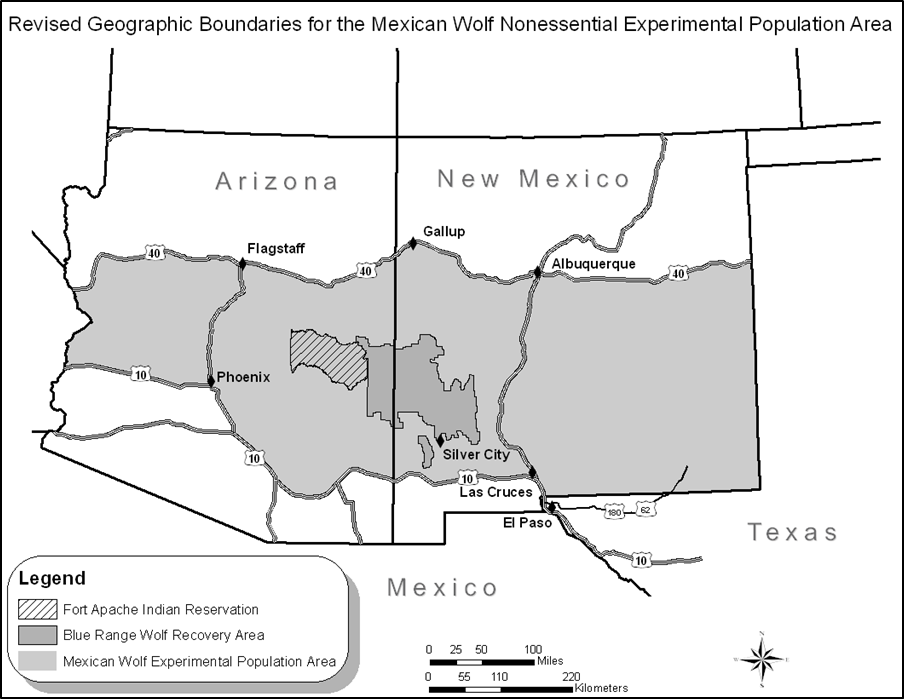Editorial: Wolf expansion plan needs more details
 Lobo friends:
Lobo friends:
This editorial was published after the AZ Game and Fish meeting in Flagstaff last week. Letters to the editor are needed to promote the changes necessary to wolf recovery. And comments on the proposal the editorial discusses are needed as well. Information on how to help with both is at the end of the article. Thank you!
If there’s a more volatile topic in wildlife management circles than wolf reintroduction, we haven’t come across it.
Which is why it’s unfathomable that the U.S. Fish and Wildlife Service would publish in the Federal Register a detailed proposal for expanding the range of the endangered Mexican gray wolf into settled areas of Arizona and New Mexico without meeting first with affected communities.
And just what are those communities? Picture the map of those two states with I-40 running across the top and I-10 across the bottom. Everything in between is where wolves would be allowed to roam, even if they are outside their designated recovery area.
That would be a big departure from the current policy, which captures and returns the wolves to their relatively small release zone in the mountains along the Arizona-New Mexico border.
The reason, as described by Fish and Wildlife in the proposal, is that wolves need much more room to sustain separate packs than they currently have been given. Further, the dispersal will promote greater genetic diversity and hence a healthier species.
We aren’t wolf experts, so we’ll leave the details of such a plan to wildlife biologists. But we’ll note that the plan has taken immediate heat from two factions: ranchers who want to limit the wolves’ range as much as possible, and wolf supporters who say the expansion is in the wrong place — it should be north of the Grand Canyon, not south.
As for the millions of other people who live in the proposed new wolf zone, their reaction has been muted mainly because they haven’t heard about it. As we noted at the beginning, Fish and Wildlife hasn’t exactly gone out of its way to publicize the plan.
If they had, we imagine that officials in Phoenix, Tucson and Albuquerque — all cities with neighborhoods within the new wolf range — would have weighed in or at least convened some public meetings. And then there are the dozens of small cities that also would be affected, including Flagstaff.
At the least, Fish and Wildlife owes residents of these communities some answers to questions like how often they’d anticipate that wolves establishing new territories would roam into suburbs and other settled areas, how they would interact with pet dogs in particular, and what tactics and strategies could be employed to keep those human-wolf contacts to a minimum.
 They also owe wolf enthusiasts a detailed answer to their question: Why stop at I-40? A look at the map, at least in Arizona, shows far more wilderness north of the interstate than south of it, or at least north of the Grand Canyon. If the wolves in the new zone can cross Interstate 17 safely, surely they can cross I-40, too.
They also owe wolf enthusiasts a detailed answer to their question: Why stop at I-40? A look at the map, at least in Arizona, shows far more wilderness north of the interstate than south of it, or at least north of the Grand Canyon. If the wolves in the new zone can cross Interstate 17 safely, surely they can cross I-40, too.
Instead, Fish and Wildlife has opened a 90-day comment period on the proposal without supplying enough information for informed discussion. That has ceded the field both to the alarmists and the pie-in-the-sky wolf lovers rather than focus on what is realistic and healthy for wolves and humans alike.
As we reported last week, the Arizona Game and Fish Commission has told its staff to begin meeting with the Fish and Wildlife counterparts to at least learn more about the wolf expansion plan. But that’s really not enough. If Fish and Wildlife is serious about such a proposal, it owes the residents of the new zone a lot more details, and soon.
This editorial was published in the Arizona Daily Sun.
***********************************************************************************************************************************************
PLEASE SUBMIT A LETTER TO THE EDITOR TODAY SUPPORTING MEXICAN WOLF RECOVERY
The letters to the editor page is one of the most widely read, influential parts of the newspaper. One letter from you can reach thousands of people and will also likely be read by decision-makers. Tips and talking points are below, but please write in your own words, from your own experience. Don’t try to include all the talking points in your letter.
Talking points
- The USFWS should move forward with allowing new wolves to be released throughout the Blue Range. The Mexican gray wolf is the most endangered mammal in the U.S. with only about 75 in the wild. Additional wolves must be released into the wild now to increase the genetic health of the species. Numerous wolves are in captive breeding facilities around the country, prepared for, and awaiting, release.
- Scientific experts have long said that the Grand Canyon region, which extends from southern Utah to the Mogollon Rim, contains some of the last best places for wolves.
- Wolves once lived throughout Arizona and played a critical role in keeping the balance of nature in place. We need to restore this important animal that has been missing for too long.
- Mexican wolves have been on the ground in Arizona for 15 years, and are struggling because of artificial boundaries and political interference.
- Wolves need freedom from boundaries. Given room to roam, the wolves will establish themselves in suitable areas with adequate game. The problem with the USFWS proposal is not that it lets wolves roam in the wrong place (it doesn’t) but that it does not allow wolves to establish new packs and populations in additional areas that are essential to their recovery.
- Wolves will bring ecological and economic benefits to our region. We should focus on what is necessary to recover the species.
- Prominent wolf experts have advocated restoring wolves to their natural role in the Grand Canyon region for many years and the Grand Canyon Wolf Recovery Project has conducted extensive public outreach and education throughout the region.
- The livestock industry has a responsibility to share public lands with native wildlife like wolves. According to the US Dept of Agriculture, in 2010 only .23% of cattle deaths and 4% of all sheep deaths were due to any type of predator, which includes a lot more than just wolves.There are many proven-effective methods for avoiding conflict.
- Science has repeatedly demonstrated that wolves are keystone carnivores who help to keep wildlife like elk and deer healthy and bring balance to the lands they inhabit. Wildlife biologists believe that Mexican wolves will improve the overall health of the Southwest and its rivers and streams — just as the return of gray wolves to Yellowstone has helped restore balance to its lands and waters.
Make sure you:
- Acknowledge the article: E.g. “Thanks for your editorial”¦” or “I was (shocked, troubled, pleased) to read·”¦ USE YOUR OWN WORDS, don’t cut and paste.
- Include something about who you are and why you care: E.g. “I am mother, outdoors person, teacher, business owner, scientific, religious, etc.)
- Provide your name, address, phone number and address. The paper won’t publish these, but they want to know you are who you say you are.
- Submit letters (<250 words) here.
Please also submit comments on the US Fish and Wildlife Service’s proposal. Click here.
_____________________________________________________________________________________________________________________
Click here to join our email list for Mexican gray wolf updates and action alerts.
Visit us on Facebook here.



